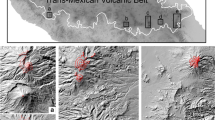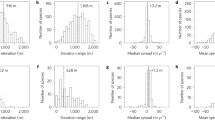Abstract
The tropical alpine ecosystem in eastern Africa is highly fragmented among biological ‘sky islands’, where populations of frost-tolerant organisms are isolated from each other by a ‘sea’ of tropical lowlands. One-third of the species in the afroalpine flora are exclusively alpine, but the other species can to varying degrees extend into grasslands and open forests of lower vegetation belts. A long-debated question is whether colonization of the alpine zone of these mountains and subsequent intermountain gene flow entirely depend on long-distance dispersal across unsuitable habitats, or whether suitable habitats shifted far enough downslope under past colder climates to form bridges enabling gradual migration. Here we address this question using a classification tree model. We mapped the extent of the current alpine habitat and projected it to the last glacial maximum (LGM) climate to assess whether gradual migration was possible for exclusively alpine taxa during this glacial period, and thus potentially also during earlier Pleistocene glaciations. Next, we modelled landcover under current and LGM climates to assess whether grassland and open forests could have served as migration corridors for alpine taxa that today extend into lower vegetation belts. We estimated that the LGM treeline was about 1000 m lower and the alpine habitat was about eight times larger than that today. At the LGM, we found that most of the currently fragmented alpine habitat of the Ethiopian highlands was interconnected except across the Great Rift Valley, whereas the solitary mountains of East/Central Africa remained isolated for exclusively alpine species. However, for drought-tolerant alpine species that today extend below the treeline, gradual migration through habitat corridors may have been possible among mountains during the dry glacial periods, and possibly also under the current climate before agriculture transformed the low-lying landscapes.








Similar content being viewed by others
References
Arino O, Ramos Perez JJ, Kalogirou V, Bontemps S, Defourny P, Van Bogaert E (2012) Global Land Cover Map for 2009 (GlobCover 2009). In: PANGAEA—Data Publisher for Earth and Environmental Science.
Assefa A, Ehrich D, Taberlet P, Nemomissa S, Brochmann C (2007) Pleistocene colonization of afro-alpine “sky islands” by the arctic-alpine Arabis alpina. Heredity 99:133–142
Baker BH, Mohr PA, Williams, L.A.J. (1972) Geology of the Eastern Rift System of Africa. Geol Soc Am Spec Pap 136:67
Bonnefille R, Roeland JC, Guiot J (1990) Temperature and rainfall estimates for the past 40,000 years in equatorial Africa. Nature 346:347–349
Coetzee JA (1964) Evidence for a considerable depression of the vegetation belts during the upper Pleistocene on the East African Mountains. Nature 204:564–566
Darwin CR (1859) On the origin of species by means of natural selection, or the preservation of favoured races in the struggle for life. John Murray, London
deMenocal PB (1995) Plio-Pleistocene African climate. Science 270:53–59
Ehrich D, Gaudeul M, Assefa A, Koch MA, Mummenhoff K, Nemomissa S, Brochmann C (2007) Genetic consequences of Pleistocene range shifts: contrast between the Arctic, the Alps and the East African mountains. Mol Ecol 16:2542–2559
Gehrke B, Linder HP (2009) The scramble for Africa: pan-temperate elements on the African high mountains. Proc R Soc Biol Sci 276:2657–2665
Gehrke B, Linder HP (2011) Time, space and ecology: why some clades have more species than others. J Biogeogr 38:1948–1962
Gehrke B, Linder HP (2014) Species richness, endemism and species composition in the tropical Afroalpine flora. Alpine Bot 124:165–177
Gizaw A, Kebede M, Nemomissa S, Ehrich D, Bekele B, Mirré V, Popp M, Brochmann C (2013) Phylogeography of the heathers Erica arborea and E. trimera in the afro-alpine ‘sky islands’ inferred from AFLPs and plastid DNA sequences. Flora Morphol Distrib Funct Ecol Plants 208:453–463
Gizaw A, Wondimu T, Mugizi TF, Masao CA, Abdi AA, Popp M, Ehrich D, Nemomissa S, Brochmann C (2016) Vicariance, dispersal, and hybridization in a naturally fragmented system: the afro-alpine endemics Carex monostachya and C. runssoroensis (Cyperaceae). Alpine Bot 126:59–71
Gottelli D, Marino J, Sillero-Zubiri C, Funk SM (2004) The effect of the last glacial age on speciation and population genetic structure of the endangered Ethiopian wolf (Canis simensis). Mol Ecol 13:2275–2286
Harmsen R, Spence JR, Mahaney WC (1991) Glacial interglacial cycles and development of the afroalpine ecosystem on East-African Mountains 0.2. Origins and development of the biotic component. J Afr Earth Sci 12:513–523
Hedberg O (1951) Vegetation belts of the East African mountains. Sven Bot Tidskr 45:140–202
Hedberg O (1957) Afroalpine vascular plants. A taxonomic revision. Symb Bot Ups 15:1–411
Hedberg O (1964) Features of afroalpine plant ecology. Acta Phytogeogr Suec 49:1–144
Hedberg O (1970) Evolution of the Afroalpine flora. Biotropica 2:16–23
Hijmans RJ, Cameron SE, Parra JL, Jones PG, Jarvis A (2005) Very high resolution interpolated climate surfaces for global land areas. Int J Climatol 25:1965–1978
Kebede M, Ehrich D, Taberlet P, Nemomissa S, Brochmann C (2007) Phylogeography and conservation genetics of a giant lobelia (Lobelia giberroa) in Ethiopian and Tropical East African mountains. Mol Ecol 16:1233–1243
Knox EB, Palmer JD (1998) Chloroplast DNA evidence on the origin and radiation of the giant lobelias in eastern Africa. Syst Bot 23:109–149
Koch MA, Kiefer C, Ehrich D, Vogel J, Brochmann C, Mummenhoff K (2006) Three times out of Asia Minor: the phylogeography of Arabis alpina L. (Brassicaceae). Mol Ecol 15:825–839
Körner C (2012) Alpine Treelines. Springer, Basel
Körner C, Paulsen J (2004) A world-wide study of high altitude treeline temperatures. J Biogeogr 31:713–732
Lambin EF, Geist HJ, Lepers E (2003) Dynamics of land-use and land-cover change in tropical regions. Annu Rev Environ Resour 28:205–241
Mark BG, Osmaston HA (2008) Quaternary glaciation in Africa: key chronologies and climatic implications. J Quatern Sci 23:589–608
Masao C, Gizaw A, Piñeiro R, Tusiime F, Wondimu T, Abdi A, Popp M, Gussarova G, Lye K, Munishi P, Nemomissa S, Brochmann C (2013) Phylogeographic history and taxonomy of some afro-alpine grasses assessed based on AFLPs and morphometry: Deschampsia cespitosa, D. angusta and Koeleria capensis. Alpine Bot 123, 107–122.
Monserud RA, Leemans R (1992) Comparing global vegetation maps with the Kappa statistic. Ecol Modell 62:275–293
Popp M, Gizaw A, Nemomissa S, Suda J, Brochmann C (2008) Colonization and diversification in the African ‘sky islands’ by Eurasian Lychnis L. (Caryophyllaceae). J Biogeogr 35:1016–1029
Rundel PW (1994) Tropical alpine climates. Tropical Alpine Environments: Plant Form and Function (ed. by P.W. Rundel, A.P. Smith and F.C. Meinzer). Cambridge University Press, Cambridge, pp 21–44
Schneider von Deimling T, Ganopolski A, Held H, Rahmstorf S (2006) How cold was the Last Glacial Maximum? Geophys Res Lett 33:L14709. doi:10.1029/2006GL026484
Shanahan TM, Zreda M (2000) Chronology of Quaternary glaciations in East Africa. Earth Planet Sci Lett 177:23–42
Sklenář P, Hedberg I, Cleef AM (2014) Island biogeography of tropical alpine floras. J Biogeogr 41:287–297
Smith, J.M.B., Cleef AM (1988) Composition and origins of the worlds tropical alpine floras. J Biogeogr 15:631–645
Spence JR, Pocs T (1988) Distribution patterns in the Afroalpine moss flora of East Africa. Quaternary and Environmental Research on East African Mountains (ed. by W.C. Mahaney). Balkema, Rotterdam, pp 291–307
Therneau TM, Atkinson EJ (2015) An introduction to recursive partitioning using the raprt routines. Available at: https://cran.r-project.org/web/packages/rpart/vignettes/longintro.pdf
Thompson LG, Mosley-Thompson E, Davis ME, Henderson KA, Brecher HH, Zagorodnov VS, Mashiotta TA, Lin PN, Mikhalenko VN, Hardy DR, Beer J (2002) Kilimanjaro ice core records: evidence of holocene climate change in tropical Africa. Science 298:589–593
Umer M, Lamb HF, Bonnefille R, Lezine AM, Tiercelin JJ, Gibert E, Cazet JP, Watrin J (2007) Late Pleistocene and Holocene vegetation history of the Bale Mountains, Ethiopia. Quatern Sci Rev 26:2229–2246
Wallace AR (1876) The Geographical Distribution of Animals: With a Study of the Relations of Living and Extinct Faunas as Elucidating the Past Changes of the Earth’s Surface. Harper and brothers, New York
Wondimu T, Gizaw A, Tusiime F, Masao C, Abdi A, Gussarova G, Popp M, Nemomissa S, Brochmann C (2014) Crossing barriers in an extremely fragmented system: two case studies in the afro-alpine sky island flora. Plant Syst Evol 300:415–430
Acknowledgements
We acknowledge financial support by the Norwegian State Loan Fund (Lånekassen); Natural History Museum, University of Oslo and the PET and GEco research groups at the Museum. We thank Achilleas Psomas, Swiss Federal Research Institute (WSL), and all members of PET and GEco for discussions on the manuscript.
Author information
Authors and Affiliations
Corresponding author
Ethics declarations
Conflict of interest
The authors declare that they have no conflict of interest.
Declaration of authorship
DC and CB conceived the paper together with NZ and VB. DC prepared the GIS layers, wrote the R script and carried out ecological modelling under the guidance of NZ and VB. DC wrote the manuscript under the guidance of CB and with critical reviews and contributions from all coauthors.
Electronic supplementary material
Below is the link to the electronic supplementary material.
Rights and permissions
About this article
Cite this article
Chala, D., Zimmermann, N.E., Brochmann, C. et al. Migration corridors for alpine plants among the ‘sky islands’ of eastern Africa: do they, or did they exist?. Alp Botany 127, 133–144 (2017). https://doi.org/10.1007/s00035-017-0184-z
Received:
Accepted:
Published:
Issue Date:
DOI: https://doi.org/10.1007/s00035-017-0184-z




